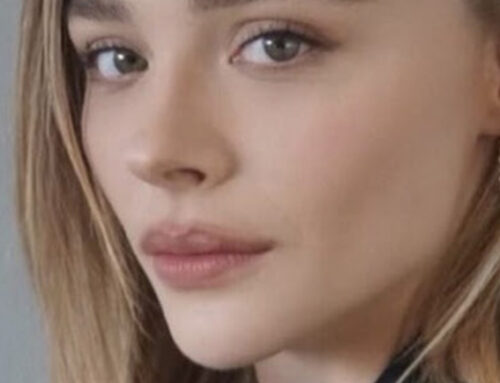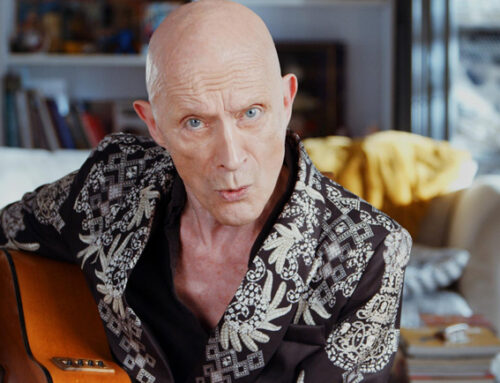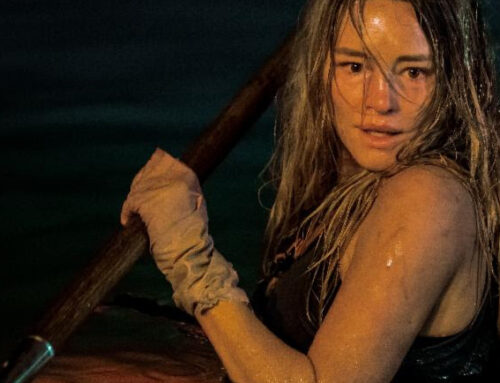Level 33 Entertainment is the distributor behind such horror films as Companion, The House Across the Street, Haunted Trail and The Domestic. Their latest feature is titled Belle and is a reimagining of the classic tale of Beauty and the Beast. In the recently released film, “Belle would do anything to save her ailing father so she journeys in search of a mythical rose believed to be a cure. As payment for the rose, Belle must surrender herself to a vicious beast and battle his spell.” Showcased at the Popcorn Frights Film Festival, Belle was nominated for the Audience Award Festival Favorites at the SXSW Film Festival and for the Global Health Competition Best Film at the Cleveland International Film Festival.
Matt Orenstein, whose other credits include Gongoli, Earth Over Earth and Daddy to name a few, served as the film’s composer. To learn more about the process for creating the Belle score, we conducted the below Q&A.
Belle is now available on VOD.
-How long did it take you to score the film? What did that process look like?
I wrote most of the score between March and December of 2020, but the summer before that I went to Iceland. Max Gold, Belle director and a friend from way back, told me that I couldn’t do this film justice unless I came out to Iceland and got the country in my bones. I read several drafts of the script, but there was always one constant: Iceland. The way it felt, the way it could serve as a backdrop for his story, it was foundational to the movie he wanted to make. I went in summer of 2019 to visit some of the sets, but mostly to explore and get some impressions. This wasn’t an ethnomusicology mission at all. I just wanted to have a frame of reference for reacting to the picture.
We worked on the whole thing remotely. The first few months were at the height of Covid, George Floyd’s murder, protests, and what felt like a string of nightmares in the news. It was also really hot in my apartment. I can’t work with AC on because it interferes with my ability to record and mix, so between the heat and the circumstances it literally felt like hell for a minute. Given all this, I wasn’t doing great, and I was struggling to score some of the story beats we needed to hit because I don’t think I was able to think as clearly as I normally can.
One day in June, Max gave me some temp that he wanted me to refer to. All of the sounds on it were made using custom, hand-built instruments. So I couldn’t get sample libraries for them. I also couldn’t build anything and record it because the helicopters could start flying above my apartment at anytime and who knows when they’d stop. I was about ready to break, but then something happened. I remember my thinking shifting in an instant from “what have I gotten myself into” to “holy shit, this is my job and I GET to do this! I get to make weird sounds and they help tell a cool story! And I get to do this now, when the world looks worse than I’ve ever seen it.” From there on out, working on the score started to feel like a lifeline, and I felt like I had my mojo back. We tweaked the tone of the film over the next few months, along with editor Patrick Lawrence, until we figured out how to shape the sounds and ideas that influenced us into something uniquely ours.
We revised the music more than I ever have on a film, but every revision felt like we were discovering something new. I know how that sounds, but I’m completely serious. After that initial burnout, working on the score – no matter how many revisions we did – was just fun and rejuvenating. Intense to the end, but really fun.
-Did you watch any other horror films to get inspiration for your Belle score?
Max and I talked a lot about The Witch and Midsommar, two of our favorites. The Witch was how we started our discussion about creating a horror music sound within our world, and Midsommar was really useful for talking about how to treat the more pensive moments. When we started to think bigger in terms of sound, we talked about Insidious and Us (my favorite Michael Abels score), and at this point I watched Hereditary to see in context what Colin Stetson did. I also went back and listened to some of the work by composers that I learned about from watching The Exorcist when I was a teenager, like George Crumb and Krysztof Penderecki, since the textures they pioneered show up in all things horror.
-Do you like more freedom or more direction when you are creating a score?
I don’t think it’s an either or thing; I think if you can build a sense of trust with the director, you can have an environment where you’re taking a lot of direction AND you feel free to help tell the story in a way that makes sense. If we can build that sense of trust, I usually have all the musical freedom I need since the story always dictates the choices I make (and the sounds the director and I each have in mind). And I always count on the director’s feedback to get the score to a place where it feels like it belongs with the movie.
-We heard you worked on this film remotely, all during Covid. How would you have scored this film differently, if at all, if you would have been able to do it not remotely?
I don’t know if I would’ve done it differently, but I can tell you that parts of it might’ve been much easier in person. There are so many micro adjustments to make to tether a score like this to picture, and many of them are easier to literally point to than they are to communicate in writing. So there were times where it would take us days to fix a small part of the score that would’ve taken about five minutes if Max and I could’ve gotten into the room together. The flip side is that since we were working remotely in different time zones, we all understood that everything could take a little longer. So some musical ideas had a longer gestation time, and when they finally made it into the score they were more well-considered and fit better than they would’ve had we had less time to fine tune them.
-You must work very closely with the director and producers when you are scoring a film, but what other departments and crew positions are helpful or important for your process?
Patrick was a part of most of the conversations I had about score, right along with Max. Patrick and I have worked together a bunch in the last seven years (since I moved out here), and I’ve learned more from him than I’ve learned from just about anybody when it comes to scoring to picture. I’ve found that working closely with the editor is every bit as important as working with the director. My goal is always to make sure that the score fits the movie perfectly, and who better to talk to than the person who’s cutting it? With a score like Belle, it was also important to keep an eye on what sound design is doing, and our sound designer Josh Ascalon did amazing work creating a believable sonic world where the unreal could exist side by side with the real. That was a goal of mine with my score too. Casey Hartig, our sound recordist in Iceland, maybe gave me the most helpful bit of insight when it came to writing my score. I had the idea that I’d go around Iceland recording nature sounds, and he told me that most of the natural soundscape was just wind. He was right. So I went around listening to and recording different kinds of wind, listening to the way silence reverberated in the different kinds of empty spaces, and then tried to weave what I found into the score. Lauren Bates, our producer, and Jared Kruger, our Assistant Director, are both wonderful, and were extremely helpful when I was in Iceland (and tolerated my tagging along to shoots when space in the convoys was limited). And getting to hang with Ingi Hrafn Hilmarsson and Andrea Snaedal, our two leads, gave me a little more perspective on their performances and helped me craft their themes.
-Was there an instrument you used in Belle that made the most “horror like” sounds?
All the instruments I chose to use on the Belle score were ones that could make romantic sounds and horrific ones, and could switch between the two moods instantaneously. The upright bass was probably the one I used the most, since I’m a bass player by training. I played a lot of the more lyrical melodies on it, along with some of the higher, glassy drones that are probably more felt than heard all over the score, but with just a little bit of bow pressure I could choke the drones in a way that created a more violent sound. I also bowed the tailpiece to get this kind of alien, guttural rumble that doesn’t quite sound like anything else. Even the way that you play the low notes on the instrument can sound unsettling if you do it in a certain way; if you’re playing in tune, the bass adds a really solid foundation. If you’re playing slightly out of tune (I liked to play two notes a quarter note apart at times on this score), it starts to feel like you’re standing on shaky and dangerous ground. My favorite horror music is disorienting … there’s nothing to latch onto, so the danger could be coming from anywhere. So that was something I wanted to accomplish with Belle’s more horrifying musical moments, and the bass was a useful tool.
-Do you find yourself going back to different pieces of the Belle score to refine them when you saw how they worked with the visuals?
I’ll take it a step further: I didn’t write a note until I had visuals to work with. Once I had picture and I started writing, I was constantly revising as we tweaked the edit and the tone of the film as a whole. I had some vague ideas of what I wanted the score to sound like, but I kept them vague so I could prioritize what we got on film as a reference. Our goal was to have a score that fit the picture as well as possible, so part of that for me was having music that had its beginnings in the picture itself.
-What horror film scores have had the biggest impact on you?
Oh boy. How much time do you have? For starters, Mark Korven’s score for The Witch might be my favorite horror score ever. It’s terrifying on its own, but it sounds like it’s coming from the same world as the picture in a way that not many scores do, horror or otherwise. It came out when I moved to LA, so it hit me just as I was starting to build my life out here.
The Sixth Sense is what showed me the power of film music. I saw it in theaters when I was a kid, and it kept me up for about two weeks afterwards, mostly because of the music. James Newton Howard’s buzzing score right before a jump scare when Cole’s hair starts to stand on end because he knows he’s about to see something horrific stuck with me in a big way.
Beyond the Black Rainbow by Sinoia Caves. I love how spare this score is. It does a great job of setting an atmosphere of disorienting dread in a way that fits the film like a glove. It also meshes so well with the sound design and the picture. A lot of that has to do with the sound palate; the synth sounds he gets are perfect for this movie.
These two are more placements than original scores, but they’re what got me into contemporary classical music, and opened my ears up to what scores (and orchestral ensembles) could do. And how scary they could sound. The Exorcist and The Shining. I wound up studying some of these composers and pieces in music school, and the reason why I was interested at all was because this music was attached to some of the most arresting visuals I had ever seen.
More on Matt Orenstein can be found here: https://mattorenstein.com/.







